Pawscessories is reader-supported. When you buy via links on our site, we may earn an affiliate commission at no cost to you.
Learn more.
Have you ever seen a brown spot on your dog’s eye and wondered what it was?
If so, you’re not alone. Brown pigment in the white of a dog’s eye is quite common, but that doesn’t mean it’s not a cause for concern.
Two conditions can cause brown spots on a dog’s eye, including Melanoma and pigmentary keratitis. While neither of these is necessarily life-threatening, they can both lead to serious complications if left untreated.
This article will cover why dogs get brown spots on their eyes, what eye melanoma and pigmentary keratitis are, and how they affect a dog. We will also discuss symptoms, diagnosis, and treatment options for both conditions.
Let’s dive in.
Table of Contents
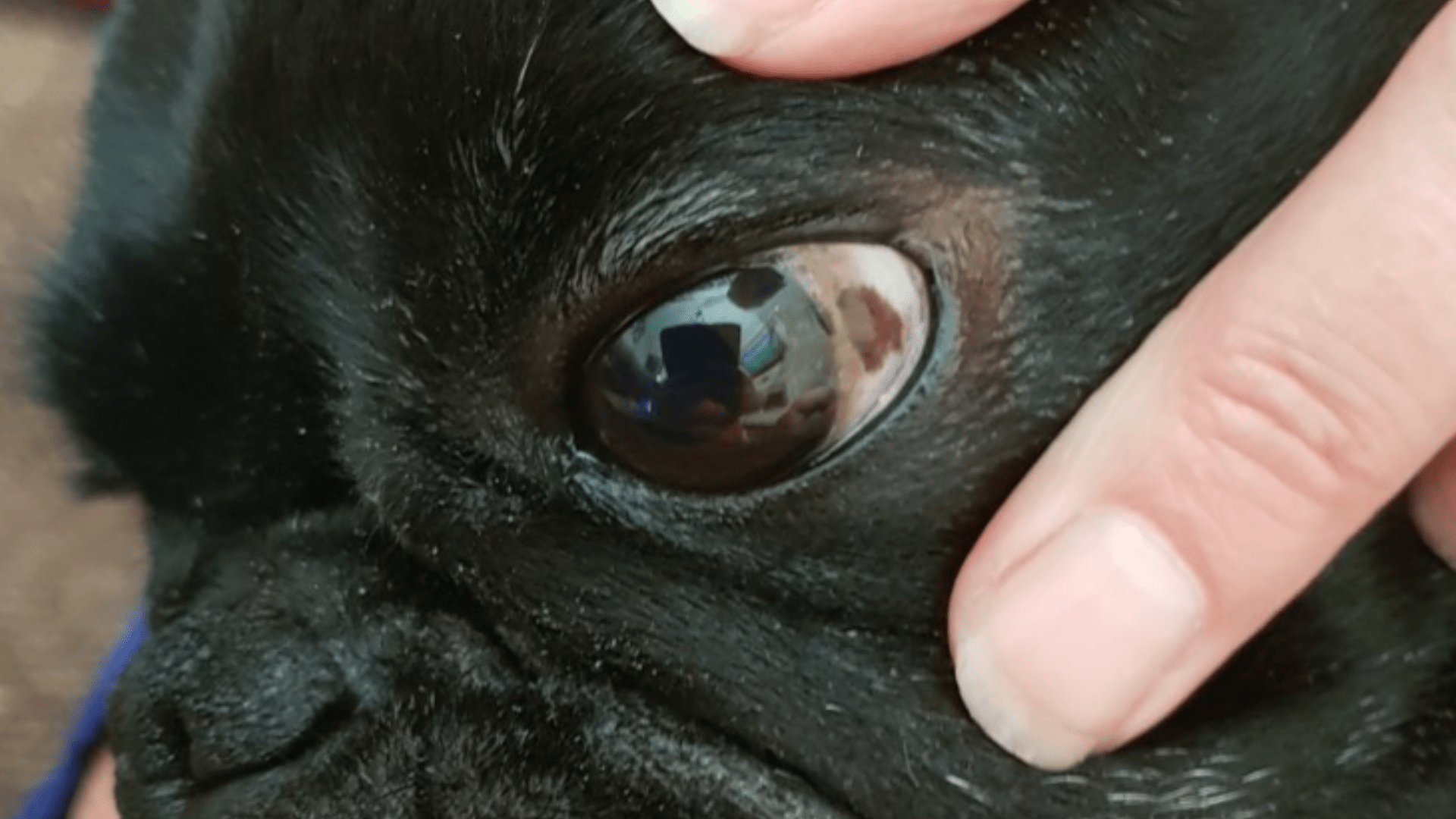
Brown Pigment In White Of Dog’s Eye: What Is It?
A couple of things could indicate brown spots in a dog’s eyes. The first is pigmentary keratitis, when the melanin in a dog’s iris (the colored part of the eye) starts to build up in the cornea (the clear part of the eye).
This is commonly found in brachiocephalic breeds (breeds with short noses), such as:
- Frenchies
- Boxers
- Pugs
- Bulldogs
Another reason for the brown pigment in the white of a dog’s eye is Melanoma. This is a type of cancer that starts in the cells that produce melanin.
While pigmentary keratitis is not cancerous, it can lead to blindness if left untreated. Eye melanoma, on the other hand, is cancerous and can spread to other parts of the body if not caught early.
So now that we know what brown pigment in the white of a dog’s eyes means let’s take deeper dive into each of these reasons.
Pigmentary Keratitis
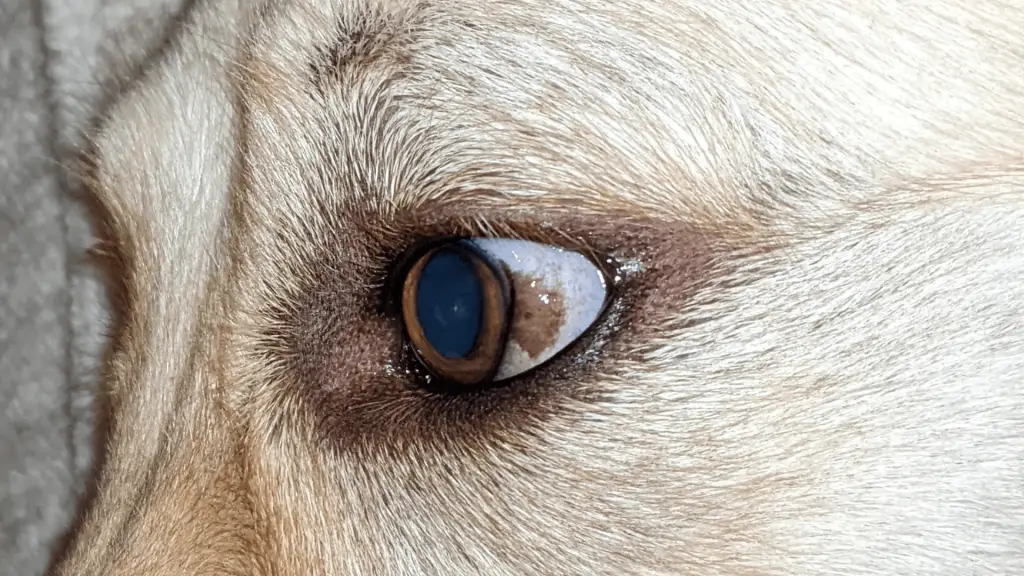
The first reason a dog could have brown spots or coloration on the white part of their eye is because of Pigmentary Keratitis.
What Is Pigmentary Keratitis?
Pigmentary keratitis is a condition where the melanin in a dog’s iris builds up in the cornea. While pigmentary keratitis is not cancerous, it can lead to serious health issues like blindness if left untreated.
How Do Dogs Get Pigmentary Keratitis?
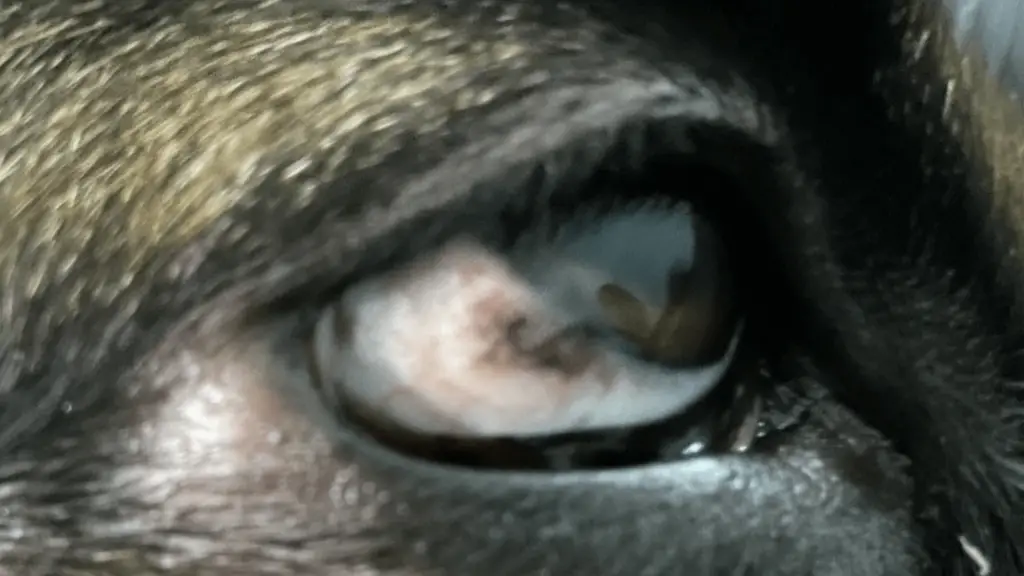
Pigmentary keratitis is most commonly found in brachiocephalic breeds (breeds with short noses) because they have shorter airways, which can lead to inflammation and eye irritation.
When there is chronic inflammation in a dog’s eye, melanin is produced as a way to protect the eye from damage. This melanin then starts to build up in the cornea, which can lead to vision problems.
Pigmentary keratitis is also seen in older dogs because they are more likely to have dry eyes, which is another condition that can cause inflammation and irritation of the eye.
Here are some common causes of Pigmentary Keratitis in dogs:
- Entropion – eyelid that rolls inward
- Ectropion – eyelid that rolls outward
- Abnormal eyelash position
- Autoimmune disease
- Eyelid tumors or other growths
- Eye trauma
- Repetitive corneal ulcers
- Abnormal blink reflexes
- Previous eye surgery
- Genetics
- Dry eye syndrome
- Glaucoma
- Autoimmune disease
- Fungal or bacterial growth
- Allergies
- Dry eye
- Infection
- Hormonal imbalance
Symptoms Of Pigmentary Keratitis
The most common symptom of pigmentary keratitis is a brown spot on the white part of the eye. This spot may be small initially, but it can grow over time and eventually cover the entire cornea.
This can appear as a brownish haze over the cornea or as small, dark spots on the eye’s surface. It can show up on one or both eyes.
Other symptoms of pigmentary keratitis include:
- Eye discharge
- Crusting around the eyes
- Swelling of the eyelids
- Redness around the eyes
- Enlargement of the eye
- Excessive tearing
- Pain in the eye
Pigmentary keratitis is a progressive disease, which means that it will only get worse over time if not treated. If left untreated, pigmentary keratitis can lead to blindness.
How Is Pigmentary Keratitis Diagnosed?
The first step in diagnosing pigmentary keratitis is to get a complete medical history from the owner. This will help the vet rule out any other possible conditions that could be causing the symptoms.
The next step is to do a thorough physical examination of the dog, paying close attention to their eyes.
The vet will look for factors causing eye irritation or affecting eye reflexes. They may use an ophthalmoscope to better look at the inside of the eye.
In addition, they may use a Schirmer tear test to measure tear production. This can help rule out dry eye, a common cause of pigmentary keratitis.
The vet may also take a sample of the discharge from the eye for cultures and cytology to rule out any infection or inflammation. In some cases, a biopsy of the tissue may be necessary.
How Do You Get Rid Of Pigmentary Keratitis In Dogs?
When speaking with our veterinary consultant, Dr. Littlejohn, he mentioned two main treatment options for pigmentary keratitis: medical and surgical.
The goal is to first identify what’s causing the corneal inflammation. Once determined, treatment will be recommended based on what’s causing the issue.
The most common medical treatment is topical steroids to reduce inflammation. This can be in the form of eye drops or ointments. If your dog’s eye inflammation is due to dry eye, there is medication to increase tear production. They may also recommend artificial tears to help lubricate the eye and decrease discomfort.
Surgery is a common solution to problems with the eyelid, such as tumors, irregular lashes, entropion, and ectropion. Not only does it improve the appearance of the lid, but it also protects the cornea from further damage.
Pigmentary Keratitis treatment can cost anywhere from $250 to $2,000 depending on whether they require surgery or just medication.
Can Pigmentary Keratitis Be Cured?
Pigmentary keratitis is unfortunately not reversible with any treatments. The only exception would be if the dog has dry eye, and providing the appropriate tear film could remove the pigmentation fully.
Does Pigmentary Keratitis Cause Blindness?

While pigmentary keratitis does not always cause blindness, it is a progressive disease that will only worsen over time if not treated. If left untreated, pigmentary keratitis can lead to blindness. However, this only occurs in severe cases and is quite rare.
Is Pigmentary Keratitis Harmful or Painful?
Pigmentary keratitis will make dogs uncomfortable and can cause chronic irritation. Generally, it’s not painful but can cause a lot of discomfort.
It becomes harmful over time when left untreated as it can lead to issues with a dog’s vision.
Eye Melanoma
The second reason a dog could have a brown spot or coloration on the white part of their eye is because of Melanoma.
What Is Eye Melanoma?
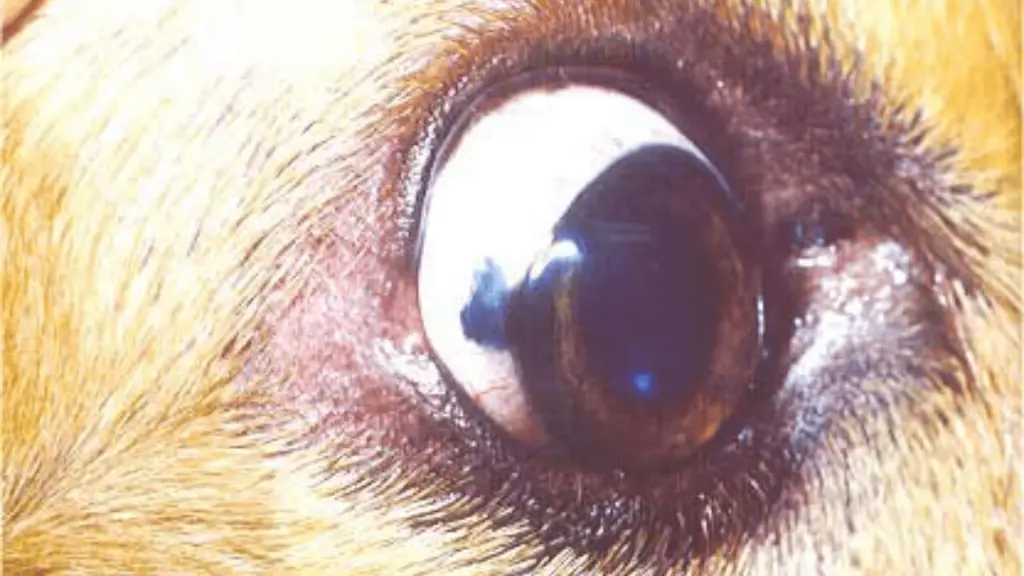
Eye melanoma, also known as ocular Melanoma, is a cancerous growth that develops in the cells that produce melanin. It can occur in any part of the eye but most commonly affects the iris or ciliary body.
There are two types of eye melanoma:
Uveal Melanoma
This type of Melanoma is a tumor that grows on the inner portion of a dog’s eye.
The uveal tumor is one of the most common and starts in the iris, ciliary body, or choroid. The is also the region called the Uvea.
This type of tumor is the most difficult to detect as it is not always visible on the eye’s surface and often does not cause any symptoms. Luckily, around 80% of uveal tumors are non-metastatic, meaning they don’t spread to other body parts. However, that does mean 20% are cancerous.
They are usually found during a routine vet visit or when the dog is examined for another condition. They can appear as a mass on the eye’s surface or as a change in the color of the iris.
Limbal Melanoma
This type of Melanoma is a tumor that grows on the outer edge of the iris, also known as the limbus. The limbus is basically a protective rim between the cornea and sclera.
Limbal melanomas are also called epibulbar melanomas because they grow on the surface of the eye. This type of tumor is easier to detect as it is visible on the eye’s surface.
Generally, these tumors are noncancerous but could be locally invasive. Most commonly, these masses develop from where they’re located and don’t spread elsewhere in the body.
They are usually smooth, have a dark brown to black pigment, and are often raised above the contour of the eye. They are more commonly seen in German Shepherds, Golden Retrievers, and Labrador Retrievers but may be seen in any breed of dog.
How Do Dogs Get Eye Melanoma?
The cause of eye melanoma is usually unknown, but a few factors have been identified. One of the most significant risk factors is exposure to ultraviolet (UV) radiation.
This means that dogs who spend a lot of time outdoors in sunny climates are more at risk for developing this type of tumor. Other potential risk factors include certain breeds predisposed to the condition and previous trauma or inflammation of the eye.
The common age range for dogs to develop this type of tumor is 6 to 12 years old, with the average being about 9 years old. However, dogs with genetic predispositions to developing eye melanoma could get it by 1 to 2 years old.
How Do Dogs Get Diagnosed?
The best way to diagnose this condition is through a comprehensive eye exam. This will include a thorough examination of the surface and interior of the eye, as well as testing your dog’s vision.
In some cases, a biopsy may be necessary to confirm the diagnosis. A small tumor sample will be taken and examined under a microscope.
Imaging tests, such as x-rays, computed tomography (CT) scans, and magnetic resonance imaging (MRI), may also be used to better look at the tumor and see if it has spread to other parts of the body.
Here are some of the tools a vet may use to diagnose eye melanomas:
- Ophthalmoscope: This small, hand-held instrument is used to look at the back of the eye. It can help the vet to see if there are any changes in the color of the iris or if there is a mass present.
- Tonometer: This device is used to measure the pressure inside the eye. This is important as high pressure can be a sign of glaucoma, a condition caused by eye tumors.
- X-rays or Ultrasounds: These imaging tests can better look at the tumor and see if it has spread to other body parts.
Symptoms Of Eye Melanoma
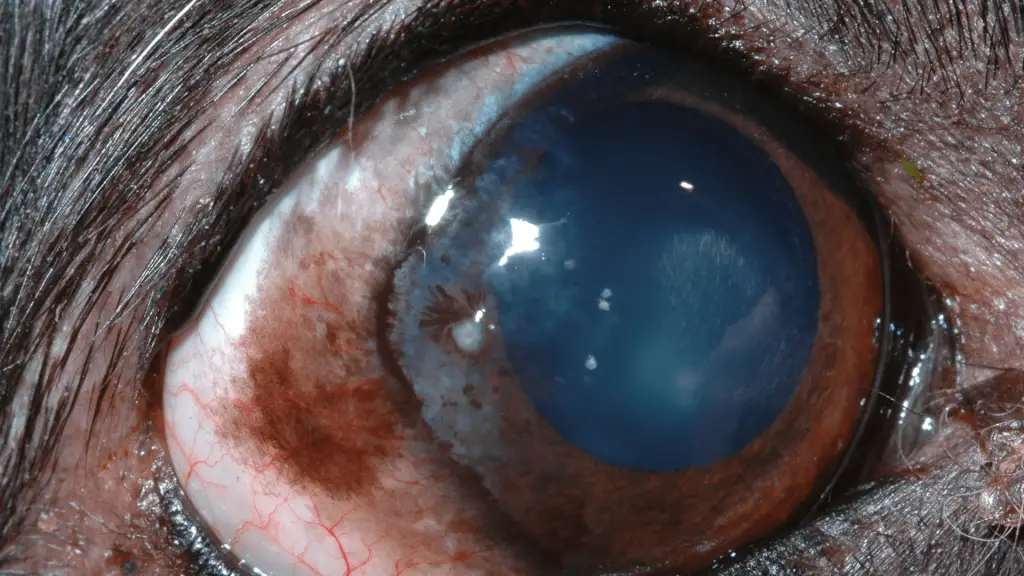
The most common symptom of this condition is a change in the appearance of the iris. This could be a change in color or a mass visible on the eye’s surface.
Other symptoms include redness, inflammation, and discharge from the eye. In some cases, the tumor may cause pressure to build up inside the eye, leading to pain and vision problems.
Suppose you notice any changes in your dog’s eye. In that case, it is important to take them to the vet for an examination as soon as possible. Again, early detection and treatment are key to managing this condition.
Here are some common symptoms:
- Internal bleeding of the eye
- Eyes turning opaque and inflamed (uveitis)
- Glaucoma
- Single or multiple brownish-black spots on the iris (sign of uveal Melanoma)
- Dark mass bulging out the pupil (sign of uveal Melanoma)
- Elevated, brownish-black spot coming from the limbus (sign of limbal Melanoma
You may also notice some strange behavior from a dog with eye melanoma. For example, dogs with eye melanoma may scratch or rub their eyes more often. This could indicate an ulcer or eye infection.
Ulcers and infections cause dogs quite a lot of pain. In addition, you may notice redness, strange eye movements, discharge, and excessive tear production.
How Do You Get Rid Of Eye Melanomas In Dogs?
The treatment for ocular Melanoma will depend on the location and size of the tumor, as well as whether it has spread to other parts of the body. The most common treatment is surgery to remove the tumor.
Surgery could include procedures such as laser surgery or partial iridectomy (removing some of the iris).
Surgery may be the only treatment necessary if the tumor is small and localized. However, suppose the tumor is large or has spread to other body parts. In that case, additional treatments such as radiation or chemotherapy may be required.
In some cases, eye removal (enucleation) may be recommended to prevent cancer from spreading further or to relieve pain and discomfort if the tumor is large.
Other Frequently Asked Questions
What Causes The White Part Of The Eye To Turn Brown?
There are two main reasons why the white part of a dog’s eye turns brown. The first is pigmentary keratitis, a condition where the cells that produce pigment in the eye become overactive and produce too much pigment.
The second reason could be eye melanoma, a type of tumor that starts in the cells that produce pigment.
Pigmentary keratitis is more common and can be caused by several things, including allergies, dry eyes, infections, and anything that causes eye inflammation. Eye melanomas are less common but tend to be more aggressive. They are usually benign but can be malignant and spread to other body parts.
What Does Pigment In The Eye Mean?
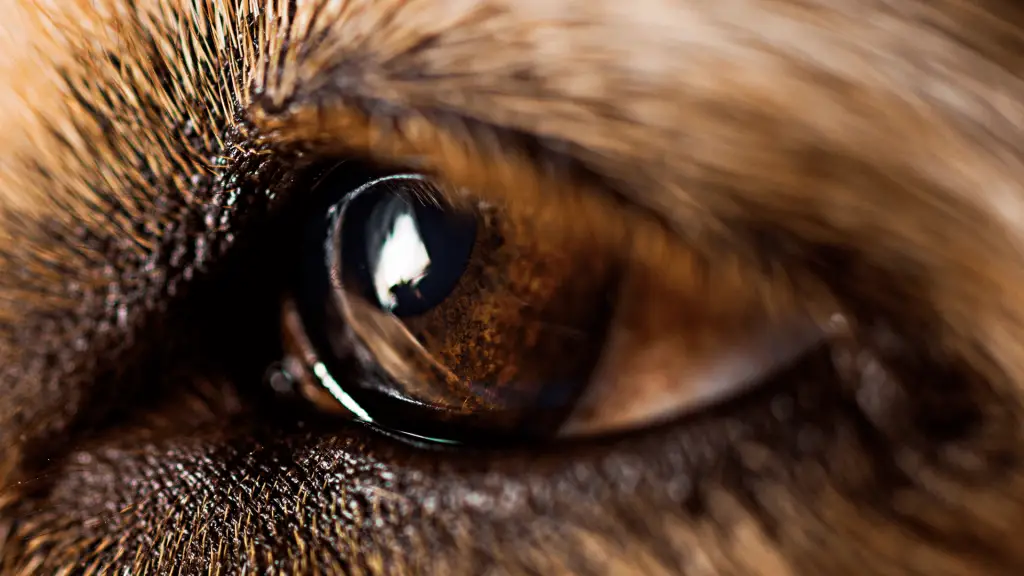
Pigment in the eye is what gives the iris its color. It is produced by cells in the eye called melanocytes. Melanocytes are also responsible for producing melanin, which is the pigment that gives a dog’s skin its color.
In some cases, these cells can become overactive and produce too much pigment, which can cause the white part of the eye to turn brown.
Why Are My Dogs Eyes Not White?
The color of a dog’s eyes is determined by the amount of pigment in the iris. If there is too much pigment, then the eyes will appear brown or black. If there is not enough pigment, then the eyes will appear pink or red.
When it comes to the sclera, if this is not white, then there is likely some sort of inflammation going on. This could be due to an infection, allergies, or dry eyes. It could also be pigmentary keratitis or uveitis, both conditions where the cells that produce pigment become overactive.
If you notice that your dog’s eyes are not white, then it is important to take them to the vet for an examination as soon as possible. Early detection and treatment are key to managing this condition.
Other posts you might find interesting:
What Age Can I Give My Puppy A Bone? Safety Tips & Options
Why Are My Dog’s Lips Turning Pink? 10 Causes & How To Fix It
